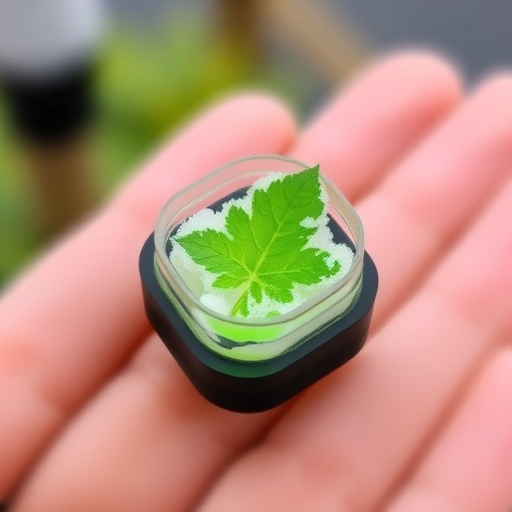In a groundbreaking advance that promises to transform our understanding of plant immunity, researchers at the University of Cambridge have developed a novel biosensor capable of visualizing the plant hormone salicylic acid (SA) at unprecedented resolution. This innovative tool, named SalicS1, is a genetically encoded sensor that reveals how SA concentrations surge and propagate within plant tissues during pathogen attacks. Until now, the dynamic signalling of SA, a pivotal molecule at the heart of plant defense mechanisms, has eluded direct observation in living plants with the necessary spatial and temporal precision.
Salicylic acid has been recognized for centuries for its medicinal properties in humans, harkening back to willow bark remedies and culminating in the widely used drug aspirin. Parallel to its role in human health, SA operates as a master immune regulator in plants, orchestrating complex defense responses against a broad spectrum of microbial invaders and pests. Plants rely on finely tuned SA signalling pathways to activate defenses precisely where and when needed, balancing immune activation with the imperative to sustain healthy growth. The ability to map this delicate trade-off in living tissues has long been a formidable challenge for plant scientists.
The research team, led by Dr. Alexander Jones at the Sainsbury Laboratory Cambridge University, has now surmounted this obstacle by creating SalicS1, a biosensor that detects changes in SA within plants with exceptional sensitivity and specificity. By fusing SA-responsive elements to fluorescent proteins, the sensor emits signals that reflect real-time fluctuations of SA concentration. This tool empowers researchers to visualize how SA accumulation begins locally at infection sites and then spreads outwards into adjacent cells and tissues, providing direct evidence of the hormone’s dynamic propagation during immune responses.
Previous methods to study SA involved destructive sampling and biochemical assays that could only provide static, averaged data, masking the spatial-temporal complexity of SA signalling. With SalicS1, scientists can monitor live plants undergoing pathogen invasion, witnessing bursts of SA that travel cell-to-cell. This insight is crucial for unraveling how plants integrate localized defense cues to coordinate systemic immunity—or systemic acquired resistance—effectively priming distant tissues for potential threats. Understanding these processes is vital for engineering crops that can resist diseases while minimizing growth penalties associated with chronic immune activation.
Dr. Jones explains that pathogens such as fungi, bacteria, viruses, and even insect pests have evolved sophisticated mechanisms to suppress SA signalling, thereby dampening plant immunity and facilitating infection. By applying SalicS1, researchers can now dissect these pathogen strategies in real time and determine how plants counteract immune suppression. This knowledge is expected to inform innovative approaches to crop protection, enabling breeders and biotechnologists to enhance disease resilience in agriculture sustainably.
The work also highlights the reversibility and non-invasive nature of the biosensor measurements, which is a major technical advancement. Unlike traditional techniques that disrupt tissues, SalicS1 allows continuous monitoring of living tissues without collateral damage. This capability will enable detailed studies on how environmental stresses—such as drought or temperature extremes—intersect with immune signalling pathways, offering a holistic view of how plants manage competing physiological demands.
Importantly, the implications of SalicS1 transcend plant biology. Given that salicylic acid is the core precursor molecule to aspirin, the most widely used pharmaceutical worldwide, a modified version of the biosensor that detects aspirin could be adapted to investigate aspirin metabolism and cellular pharmacodynamics in human cells. Such a crossover application has the potential to open new frontiers in medical research, bridging plant science and human health.
First author Dr. Bijun Tang emphasizes the dynamic and localized nature of SA signalling unveiled by SalicS1. The ability to capture hormone surges at sites of pathogen ingress reveals the precise timing and intensity of immune activation, details previously inferred but not directly observed. This represents a leap towards understanding the biochemical warfare between plants and their myriad antagonists at a cellular level, dramatically refining the conceptual model of plant-pathogen interactions.
The team’s discovery also mirrors broader biological questions relevant to animal health, such as variability in individual responses to infections. Dr. Jones draws parallels to the COVID-19 pandemic, where pathogen exposure led to dramatically different outcomes among humans. Similarly, plants exposed to identical inoculation conditions exhibit variable immune successes, partly explained now through differential SA signalling patterns observable with SalicS1.
Ultimately, these insights pave the way for novel agricultural strategies that harness precise immune modulation rather than broad-spectrum chemical treatments. By breeding or engineering crops that can dynamically deploy SA responses when and where necessary, it may become feasible to reduce pesticide usage, promote sustainable farming practices, and ensure food security in the face of mounting pathogen pressures exacerbated by climate change.
The research, published in Science, was a collaborative effort involving several institutions, with critical technical contributions from the Institute of Experimental Botany of the Czech Academy of Sciences. Funding support was provided by the Gatsby Charitable Foundation, the European Research Council, the Max Planck Society, and EMBO. As this innovative biosensor is adopted and refined, it promises to illuminate the hidden molecular choreography that underpins plant survival and resilience, inspiring a new era in both plant science and beyond.
Subject of Research: Cells
Article Title: SALICYLIC ACID SENSOR1 reveals the propagation of an SA hormone surge during plant pathogen advance
News Publication Date: 9-Oct-2025
Web References:
Science Journal
DOI: 10.1126/science.adw7650
References:
Tang, B., Lu, J., Leontovyčová, H., Hoffmann, G., Rowe, J.H., O’Donnell, S.F., Grangé-Guermente, M., Larsen, B., Wimalasekera, R., Carella, P., Incarbone, M., Kalachova, T., Jones, A.M. (2025). SALICYLIC ACID SENSOR1 reveals the propagation of an SA hormone surge during plant pathogen advance. Science. DOI: 10.1126/science.adw7650
Image Credits: Bijun Tang
Keywords: Salicylic acid, plant immunity, biosensor, SalicS1, pathogen defense, hormone signalling, systemic acquired resistance, plant-pathogen interactions, fluorescence sensor, crop resilience, aspirin metabolism, cellular dynamics
Tags: genetically encoded sensorsimmune regulation in plantsinnovative agricultural toolsmonitoring plant disease resistancepathogen defense mechanismsplant health and growth balanceplant hormone visualizationplant immune responseplant signaling pathwaysreal-time biosensor technologysalicylic acid dynamicsUniversity of Cambridge research





